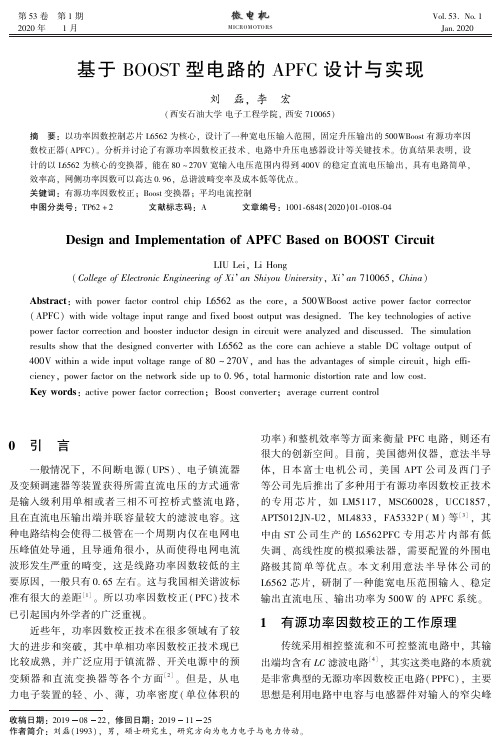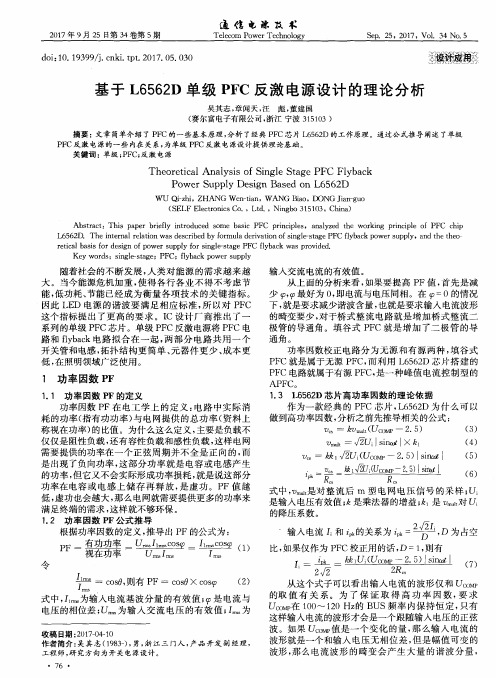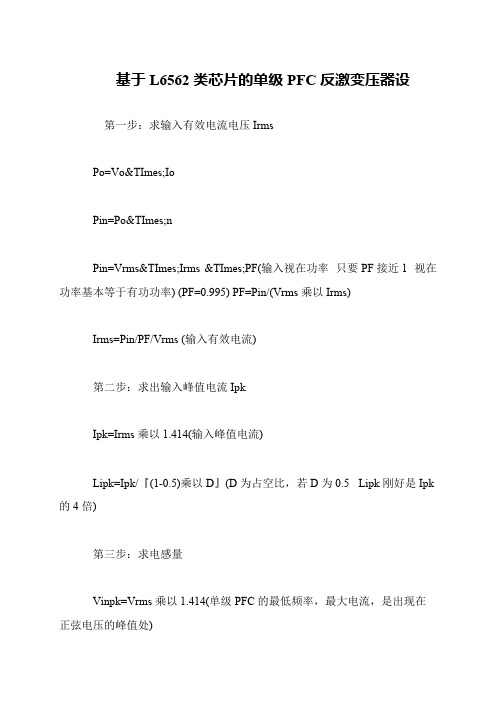基于L6562A的APFC设计
- 格式:pdf
- 大小:636.69 KB
- 文档页数:15

本栏目责任编辑:梁书计算机工程应用技术临界模式APFC 电路设计与仿真钟鑫(西安石油大学电子工程学院,陕西西安710065)摘要:为抑制电网的谐波污染,有源功率因数校正(PFC )技术的使用是必要的,分析了临界导通模式的原理和优势,对三种主流控制方法进行了简要对比,最终以L6562为核心元件设计了一种390V/250W 的新型APFC 控制电路。
借助Saber 软件搭建仿真电路进行验证,结果表明该电路的功率因数能够接近于1,能有效抑制电流谐波,提高电源利用效率。
关键词:临界导电模式;PFC ;谐波污染;功率因数;L6552中图分类号:TP62+2文献标识码:A文章编号:1009-3044(2021)02-0214-03开放科学(资源服务)标识码(OSID ):1引言采用桥式整流和大容量滤波电路的开关电源(SMPS)、电子镇流器和交流变频调速器,因为整流桥后使用了大容量的电容进行滤波,所以整流桥中的二极管只有在交流输入电压的瞬时幅值大于桥后电容上的电压时,才能从截止状态改变为导通状态[1]。
输入电压波形畸变微小,但是在极短的导通时间内,交流输入电流会出现尖峰脉冲,畸变相当严重,电流波形基波含量很低,而其次谐波含量非常高。
抑制电网谐波污染的方案主要分为两种:第一种是从电网侧解决,配备滤波器包含有源滤波器(APF )与无源滤波器(PPF );第二种是从装置侧解决,采用功率因数校正电路(PFC ),主要分为有源功率因数校正技术(APFC)和无源功率因数校正技术(PPFC ),APFC 电路使用脉冲宽度调制技术(SP⁃WM ),输入电流能够实时跟踪输入电压,高效地防止电流发生畸变,是现在常用的谐波抑制方案[2]。
本文选用工作在临界模式的功率因数控制器L6562设计了一种具有高功率因数的升压PFC 电路。
2CRM-PFC 电路分析2.1CRM-PFC 电路基本工作原理在图1所示的CRM-PFC 简化电路中,输入电压经过检测后取样到乘法器;直流电压输出后经电阻分压取样,输入到误差放大器反相端,与同相基准电压对比,生成一个电压误差信号,再反馈到乘法器的另一端。



基于L6562的高功率因数boost电路的设计0 引言Boost是一种升压电路,这种电路的优点是可以使输入电流连续,并且在整个输入电压的正弦周期都可以调制,因此可获得很高的功率因数;该电路的电感电流即为输入电流,因而容易调节;同时开关管门极驱动信号地与输出共地,故驱动简单;此外,由于输入电流连续,开关管的电流峰值较小,因此,对输入电压变化适应性强。
储能电感在Boost电路起着关键的作用。
一般而言,其感量较大,匝数较多,阻抗较大,容易引起电感饱和,发热量增加,严重威胁产品的性能和寿命。
因此,对于储能电感的设计,是Boost电路的重点和难点之一。
本文基于ST公司的L6562设计了一种Boost电路,并详细分析了磁性元器件的设计方法。
1 Boost电路的基本原理Boost电路拓扑如图1所示。
图中,当开关管T导通时,电流,IL流过电感线圈L,在电感线圈未饱和前,电流线性增加,电能以磁能的形式储存在电感线圈中,此时,电容Cout 放电为负载提供能量;而当开关管T关断时,由于线圈中的磁能将改变线圈L两端的电压VL卡及性,以保持其电流IL不突变。
这样,线圈L转化的电压VL与电源Vin串联,并以高于输出的电压向电容和负载供电,如图2所示是其电压和电流的关系图。
图中,Vcont为功率开关MOSFET的控制信号,VI为MOFET两端的电压,ID为流过二极管D的电流。
以电流,IL作为区分,Boost电路的工作模式可分为连续模式、断续模式和临界模式三种。
式(2)即为Boost电路工作于连续模式和临界模式下的基本公式。
式(2)即为Boost电路工作于连续模式和临界模式下的基本公式。
2 临界状态下的Boost-APFC电路设计基于L6562的临界工作模式下的Boost-APFC电路的典型拓扑结构如图3所示,图4所示是其APFC工作原理波形图。
利用Boost电路实现高功率因数的原理是使输入电流跟随输入电压,并获得期望的输出电压。

基于L6562A的两级式PFC电路的研究房绪鹏;李辉;庄见伟;许玉林;赵志远;许伟【摘要】Switching power supply is widely used in many fields for its high efficiency,low power consumption,high energy density,and wide range of voltage. However,the input current could not track voltage’schange,which con⁃tains a large number of odd harmonic currents,which cause a large number of harmonic pollution in the power net⁃work. Compare the existing two forms of double-stage and single-stagePFC(Power Factor Correction)power supply, L6562A and TOPswitch227 power integrated chip are used in the two stage PFC circuit,and the structure of the two stage PFC circuit is simplified. The feasibility of the proposed circuit is verified by the experimental results.%开关电源在电源领域中以其高效率、低功耗、高能量密度、电压适用范围广等优点在各行各业得到大量的应用。
然而,其输入电流并非跟踪电压变化,含有大量的奇次谐波电流,对电网造成大量的谐波污染。
对比现有两级式和单级式两种形式的PFC电源,运用L6562A芯片将TOPswitch227功率集成芯片应用于两级式PFC电路中,简化了两级PFC电路结构,并通过实验验证了所研究电路的可行性。

Data BriefFor further information contact your local STMicroelectronics sales office.October 2007 Rev 21/6EVL6562A-TM-80W80 W high performance transition mode PFC evaluation boardFeatures■Line voltage range: 88 to 265 V AC ■Minimum line frequency (f L ): 47 Hz ■Regulated output voltage: 400 V ■Rated output power: 80 W■Maximum 2f L output voltage ripple: 10 V pk-pk ■Hold-up time: 20 ms (V DROP after hold-up time: 300 V)■Minimum switching frequency: 35 kHz ■Minimum estimated efficiency: 92% (V IN = 90 V AC , P OUT = 80 W)■Maximum ambient temperature: 50 °C ■PCB type and size: single side, 35 µm, CEM-1, 108 x 57 mmDescriptionThe L6562A is a current-mode PFC controller operating in transition mode (TM). With the same pin-out as its predecessor L6562, the L6562A offers improved performance mainly in terms of efficiency and noise immunity.This board implements an 80 W, wide-range mains input and a PFC pre-conditioner suitablefor ballast, adapters, flat screen displays, etc.Electrical specification and performance EVL6562A-TM-80W2/61 Electrical specification and performanceTable 1.Bill of materialDes.Part type / partvalue DescriptionSupplierF1 Fuse 4 A Fuse T4A - time delayWichmann P1 W06600 V-1 A Single phase bridge rectifier Chenyi electronics C1 220 NF-630 V B32653-A6224-K - film capacitor Epcos C2 10 NF 50 V cercap - general purposeAvx C3 2u2F SR305E225MAR - 50 V ceramic capacitor - Z5U Avx C4 100NF 50 V cercap - general purpose Avx C5 10NF 50 V cercap - general purpose Avx C6 47 µF-450 V aluminium elcap - ED series - 85°C Daewoo C23 150NF 50 V cercap - general purpose Avx C29 22 µF-50 V aluminium elcap - YK - 85°CRubycon R1 1M0 MBB0207 axial film res - 0.4 W - 1% - 50 ppm/°C BC Components R2 1M0 MBB0207 axial film res - 0.4 W - 1% - 50 ppm/°C BC Components R3 15 K MBB0207 axial film res - 0.4 W - 1% - 50 ppm/°CBC ComponentsR4 270 K SFR25 axial stand. film res - 0.4 W - 5% - 250 ppm/°C BC Components R5 270 K SFR25 axial stand. film res - 0.4 W - 5% - 250 ppm/°C BC Components R6 47 K SFR25 axial stand. film res - 0.4 W - 5% - 250 ppm/°C BC Components R733RSFR25 axial stand. film res - 0.4 W - 5% - 250 ppm/°C BC ComponentsEVL6562A-TM-80W Electrical specification and performance3/6R8 47 K SFR25 axial stand. film res - 0.4 W - 5% - 250 ppm/°C BC Components R9 0R68 SFR25 axial stand. film res - 0.4 W - 5% - 250 ppm/°C BC Components R10 0R68 SFR25 axial stand. film res - 0.4 W - 5% - 250 ppm/°C BC Components R11 1M0 MBB0207 axial film res - 0.4 W - 1% - 50 ppm/°C BC Components R12 1M0 MBB0207 axial film res - 0.4 W - 1% - 50 ppm/°C BC Components R13 15 K MBB0207 axial film res - 0.4 W - 1% - 50 ppm/°C BC Components R13B 82 K MBB0207 axial film res - 0.4 W - 1% - 50 ppm/°CBC ComponentsR14 100 R SFR25 axial stand. film res - 0.4 W - 5% - 250 ppm/°C BC Components R15 Shorted Tinner wire jumperR5022 KSFR25 axial stand. film res - 0.4 W - 5% - 250 ppm/°C BC ComponentsD1 STTH1L06 Ultrafast high voltage rectifier STMicroelectronics D21N5248B 18V-0.5W zener diode Fairchild D8IN4148fast switching diodEVishay NTC12R5-S237 B57237S0259M000 Epcos T1 E2543/E E25x13x7 core, 0.7 mH ItacoilU1L6562ATransition mode PFC controller STMicroelectronics Q1 STP8NM50FP n-channel md-mesh Power MOSFET STMicroelectronics HS1 FK218 32 Q1 heat sink for TO-220 - 21 °C/WFischer elektronik J1 MKDS 1,5/PCB term. block, screw conn., pitch 5 mm - 3 W. Phoenix contact J2 MKDS 1,5/PCB Term. block, screw conn., pitch 5 mm - 3 W. Phoenix contact F1 Fuse 4 A Fuse T4A - time delayWichmann P1W06600 V-1 A single phase bridge rectifierChenyi electronicsTable 1.Bill of material (continued)Des.Part type / partvalue DescriptionSupplierElectrical specification and performance EVL6562A-TM-80W4/6Figure 2.EVL6562A-TM-80W: efficiency vsFigure 3.EVL6562A-TM-80W: static VoutEVL6562A-TM-80W Revision history5/62 Revision historyTable 2.Document revision historyDate RevisionChanges07-Aug-20071Initial release11-Oct-20072Document reformatted no content changeEVL6562A-TM-80W6/6Please Read Carefully:Information in this document is provided solely in connection with ST products. STMicroelectronics NV and its subsidiaries (“ST”) reserve the right to make changes, corrections, modifications or improvements, to this document, and the products and services described herein at any time, without notice.All ST products are sold pursuant to ST’s terms and conditions of sale.Purchasers are solely responsible for the choice, selection and use of the ST products and services described herein, and ST assumes no liability whatsoever relating to the choice, selection or use of the ST products and services described herein.No license, express or implied, by estoppel or otherwise, to any intellectual property rights is granted under this document. If any part of this document refers to any third party products or services it shall not be deemed a license grant by ST for the use of such third party products or services, or any intellectual property contained therein or considered as a warranty covering the use in any manner whatsoever of such third party products or services or any intellectual property contained therein.UN LESS OTHERWISE SET FORTH IN ST’S TERMS AN D CON DITION S OF SALE ST DISCLAIMS AN Y EXPRESS OR IMPLIED WARRAN TY WITH RESPECT TO THE USE AN D/OR SALE OF ST PRODUCTS IN CLUDIN G WITHOUT LIMITATION IMPLIED WARRANTIES OF MERCHANTABILITY, FITNESS FOR A PARTICULAR PURPOSE (AND THEIR EQUIVALENTS UNDER THE LAWS OF ANY JURISDICTION), OR INFRINGEMENT OF ANY PATENT, COPYRIGHT OR OTHER INTELLECTUAL PROPERTY RIGHT.UN LESS EXPRESSLY APPROVED IN WRITIN G BY AN AUTHORIZED ST REPRESEN TATIVE, ST PRODUCTS ARE N OT RECOMMENDED, AUTHORIZED OR WARRANTED FOR USE IN MILITARY, AIR CRAFT, SPACE, LIFE SAVING, OR LIFE SUSTAINING APPLICATIONS, NOR IN PRODUCTS OR SYSTEMS WHERE FAILURE OR MALFUNCTION MAY RESULT IN PERSONAL INJURY, DEATH, OR SEVERE PROPERTY OR ENVIRONMENTAL DAMAGE. ST PRODUCTS WHICH ARE NOT SPECIFIED AS "AUTOMOTIVE GRADE" MAY ONLY BE USED IN AUTOMOTIVE APPLICATIONS AT USER’S OWN RISK.Resale of ST products with provisions different from the statements and/or technical features set forth in this document shall immediately void any warranty granted by ST for the ST product or service described herein and shall not create or extend in any manner whatsoever, any liability of ST.ST and the ST logo are trademarks or registered trademarks of ST in various countries.Information in this document supersedes and replaces all information previously supplied.The ST logo is a registered trademark of STMicroelectronics. All other names are the property of their respective owners.© 2007 STMicroelectronics - All rights reservedSTMicroelectronics group of companiesAustralia - Belgium - Brazil - Canada - China - Czech Republic - Finland - France - Germany - Hong Kong - India - Israel - Italy - Japan - Malaysia - Malta - Morocco - Singapore - Spain - Sweden - Switzerland - United Kingdom - United States of America。
基于L6562的高功率因数boost电路的设计0 引言Boost是一种升压电路,这种电路的优势是能够使输入电流持续,而且在整个输入电压的正弦周期都能够调制,因此可取得很高的功率因数;该电路的电感电流即为输入电流,因此容易调剂;同时开关管门极驱动信号地与输出共地,故驱动简单;另外,由于输入电流持续,开关管的电流峰值较小,因此,对输入电压转变适应性强。
储能电感在Boost电路起着关键的作用。
一样而言,其感量较大,匝数较多,阻抗较大,容易引发电感饱和,发烧量增加,严峻要挟产品的性能和寿命。
因此,关于储能电感的设计,是Boost电路的重点和难点之一。
本文基于ST公司的L6562设计了一种Boost电路,并详细分析了磁性元器件的设计方式。
1 Boost电路的大体原理Boost电路拓扑如图1所示。
图中,当开关管T导通时,电流,IL流过电感线圈L,在电感线圈未饱和前,电流线性增加,电能以磁能的形式贮存在电感线圈中,现在,电容Cout放电为负载提供能量;而当开关管T关断时,由于线圈中的磁能将改变线圈L两头的电压VL卡及性,以维持其电流IL不突变。
如此,线圈L转化的电压VL与电源Vin串联,并以高于输出的电压向电容和负载供电,如图2所示是其电压和电流的关系图。
图中,Vcont为功率开关MOSFET的操纵信号,VI为MOFET两头的电压,ID 为流过二极管D的电流。
以电流,IL作为区分,Boost电路的工作模式可分为持续模式、断续模式和临界模式三种。
分析图2,可得:式(2)即为Boost电路工作于持续模式和临界模式下的大体公式。
2 临界状态下的Boost-APFC电路设计基于L6562的临界工作模式下的Boost-APFC电路的典型拓扑结构如图3所示,图4所示是其APFC工作原理波形图。
利用Boost电路实现高功率因数的原理是使输入电流跟从输入电压,并取得期望的输出电压。
因此,操纵电路所需的参量包括即时输入电压、输入电流及输出电压。